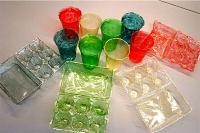
Shrilk Plastic Photo: Harvard’s Wyss Institute
Discarded plastic is a major problem in today’s oceans. Plastics leach toxic chemicals into the seawater while otherwise not degrading. Recently researchers at Harvard University have announced they have created a new bio-degrable plastic based on, of all things, shrimp shells.
We have posted for several years now about the vast floating collection of trash in the Pacific Ocean. It goes by a variety of names including the plastic vortex and the great Pacific garbage patch. It is held together by the circular current, the North Pacific Gyre. Similar garbage patches have formed in the Atlantic and Indian Oceans. The floating plastic is often deadly to sea birds, fish and whales which inject the trash. Once tossed in the oceans, the plastic simply does not go away.
Recently an international study involving 15 organisations across Europe, led by the University of the Azores completed a survey of the seafloor which found bottles, plastic bags, fishing nets and other types of human litter even in the deepest ocean depths. In the survey, plastic accounted for 41% of the trash observed.
The problem with plastic in the oceans will only get worse unless a workable alternative is found. Researchers at Harvard University’s Wyss Institute have developed a process using chitosan, a form of chitin, from shrimp shells to create a material that is strong, transparent and renewable. They’ve named it “shrilk.” Shrilk is thin, clear, flexible, and strong as aluminum at half the weight.
“There is an urgent need in many industries for sustainable materials that can be mass produced,” said Wyss director Donald E. Ingber. “Our scalable manufacturing method shows that chitosan, which is readily available and inexpensive, can serve as a viable bioplastic that could potentially be used instead of conventional plastics for numerous industrial applications.”
Not only is shrilk biodegrade, but once it’s discarded, it can be used as a fertilizer, releasing nutrients into the environment as it breaks down.

I know they made plastic out of corn, but not shrimp shells.
Lot of talk how the fish eat the broken down plastic, then they say we eat the fish that ate it.
The problem with bioplastic made from corn is all the energy and resources that go into growing the corn, and the field space not used for food production. The shrimp shells are novel in that they are being discarded anyway when shrimp are harvested for food.
I would think shrimps shell’s would make good fertilizer considering all the fish innards and bones my dad buried under our trees and in the garden.
Growing corn for fuel is a waste, its probably Dent corn not ment for humans, but the ethanol, the EPA has stated, ruins your engine, cuts your milage forcing you to buy more and put more money into the oil barons pockets.
You can buy marine gas without it, but the cost is higher, when you can find it.
Michael James Barton: Repeal the Renewable Fuel Mandat
http://www.providencejournal.com/opinion/commentary/20140525-michael-james-barton-repeal-the-renewable-fuel-mandate.ece
Seth, nd the rest,
How to find pure gaoline, no ethanol.
Not always close by.
Here is the web site for pure gas in US and Canada.
Click your 2 letter state or province letters.
Looks like it is boat motor gasoline, its sold at some boat places, at least ours is in my town
http://pure-gas.org
I try not to eat corn products, its GMO corn.
TALKING POINTS: ETHANOL FOR FOOD AND FUEL
POSTED: MAR 26, 2007
Misunderstanding corn for human consumption
– Many don’t realize that corn for ethanol and corn for human consumption are two different types. Field corn, the type used to feed livestock, goes into ethanol production. Sweet corn, a very small portion of the U.S. crop, is the type eaten by humans.
http://ethanol.org/news/?newsid=4
Bigger problems.
All that plastic is turing into rock.
Found the .PDF on a geology news web site.
Below is the artice from a different source
In Photos: New ‘Plastiglomerate’ Rock Material Found on Hawaii Beach 8 photod
http://www.news.nom.co/in-photos-new-plastiglomerate-rock-9778249-news/